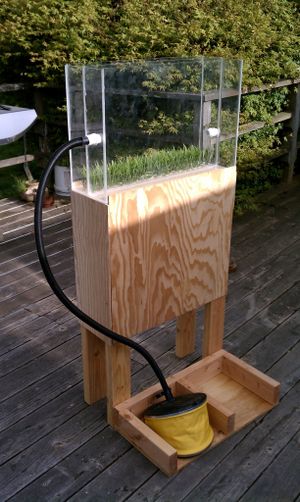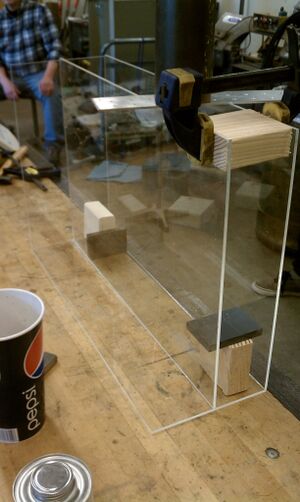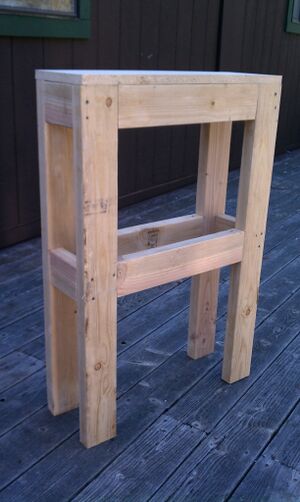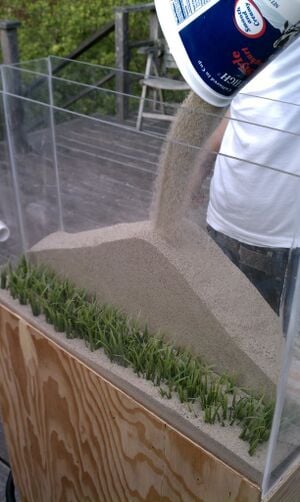
This is an interactive exhibit that demonstrates how the forces of nature contribute to the formation of sand dunes.
This page is focused on the Pump Powered Dune Movement Simulator that was created by the Cal Poly Humboldt Engr205 Introduction to Design team, Four Dudes, and the process that went into designing and building it. Our project was to create an exhibit for our client, the Friends of the Dunes, that will provided an interactive experience educating visitors about sand dunes and the processes that facilitate their movement and formation.
The Friends of the Dunes is a non-profit organization in Humboldt County, California focused on conservation of sand dunes coastal environments. One of the properties this organization owns is the Humboldt Coastal Nature Center. The Friends of the Dunes asked our team to design an exhibit for the Humboldt Coastal Nature Center that will demonstrate the formation and movement of sand dunes by the force of wind. This exhibit will be interactive, educational, and scientifically accurate.
Problem Statement and Criteria[edit | edit source]
Create a display/exhibit that will demonstrate sand dune formation on a small scale in an interactive and informative manner.
| Criteria | Constraints | Importance (1-10) |
|---|---|---|
| Noise | Quieter than 65 decibels | 8 |
| Portability | 1 person can move | 6 |
| Interactivity | At least one interactive element | 7 |
| Cost | Less than $400 | 6 |
| Aesthetics | Looks professional | 8 |
| Ease of use | Useable by almost everyone | 7 |
| Ease of maintenance | Doesn't require mechanical experience to repair | 7 |
| Scientific Accuracy | As accurate as possible on a small scale | 10 |
| Durability | 2 years no major maintenance minimum | 7 |
| Accessibility | Handicap and small children accessible | 6 |
| Safety | Safe for small children | 10 |
Description of Final Project[edit | edit source]
Photos and Descriptions[edit | edit source]
Our first step in construction was to build the acrylic tank. We used scratch-resistant acrylic sheets and attached them using acrylic glue, and we used clamps and spacers to hold the sheets together while the glue dried. Initially the scratch-resistant coating resisted the adhesive properties of the acrylic glue, so we had to carefully use sandpaper to remove the coating on the edges of the sheets where they joined with other sheets.
Our final step after constructing the acrylic tank and the wooden stand was to combine the two pieces and add finishing touches. We used silicone glue to attach small plastic aquarium plants to one half of the tank, in order to simulate the role of plants in dune formation. After the plants were attached, we poured fine sand into the tank.
Operation Instructions[edit | edit source]
Using the Pump Powered Dune Movement Simulator is simple. The steps for operation are:
- Press down gently on the pump on the right with your foot to pump air into the sand dune chamber. Do this repeatedly to gradually move the sand dune across the tank.
- Press down gently on the pump on the left with your foot to pump air into the plant chamber. Do this repeatedly to gradually move the sand dune across the tank.
- When you have finished pumping air into the sand dune chambers, carefully remove the wooden lid on top of the tank.
- Locate a small rake on the shelf inside the stand, and use it to rake the sand across each chamber towards the nozzle where the tubes connect.
- Carefully place the lid back on top of the tank and set the rake on the shelf where you found it.
Costs[edit | edit source]
The following is the breakdown of our total costs for the project. We had several items donated or were already available to us which lowered our overall cost. In the end our total cost came to around $303.62 and the cost to replicate this design would be around $361.10.
| Material | Quantity | Our Cost | Actual Cost |
|---|---|---|---|
| 16x24x0.25" Acrylic Sheets | 3 | $189.00 | $189.00 |
| 7x16X0.25" Acrylic Sheets | 2 | ||
| 7x24x.025 Acrylic Sheets | 2 | ||
| Foot Pump | 2 | $39.90 | $39.90 |
| 8' 2x4 Lumber | 3 | $30.00 | $30.00 |
| 4'x4' Panel | 2 | $25.78 | $25.78 |
| Finishing Nails | 50 | Donated | $5.00 |
| Acrylic Glue | 1 | Donated | $15.00 |
| Fine Sand | 40 lbs | $5.00 | $5.00 |
| Plastic Plants | 1 bundle | Donated | $20.00 |
| Silicone Glue | 1 | Donated | $4.00 |
| 3" Wood Screws | 100 | $9.95 | $9.95 |
| Sandpaper | 5 sheets | Donated | $4.49 |
| Wood Stain | 1 can | Donated | $8.99 |
| Velcro | 3 packs | $3.99 | $3.99 |
| Total | $303.62 | $361.10 | |
Between planning, research, analysis, collecting materials, and construction, our project had a total design cost of around 170 hours.
Testing Results[edit | edit source]
The design performed well beyond our initial expectations. In the side where the sand is unhindered by plants, the sand demonstrates the effect of saltation and a slow movement of the dune. In the side where the wind flow is hindered by plants, the sand demonstrates the effects typical of plants. The wind speed is reduced and the sand moves much slower. Overall the exhibit displays how sand dunes are formed and moved by the wind, and how invasive plant species impact the dunes. The Pump Powered Dune Movement Simulator is as accurate as we could make it on a small scale and within our available budget.


